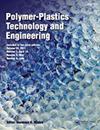sPS/PPS/Carbon Nanotube Ternary Composites with Improved Conductivity by Controlled Melt Blending Process
Q2 Materials Science
引用次数: 3
Abstract
ABSTRACT Syndiotactic polystyrene/poly(phenylene sulfide)/carbon nanotube ternary nanocomposites were prepared using a controlled melt blending process. The composites exhibited sea–island structures of syndiotactic polystyrene as continuous phase and poly(phenylene sulfide) as dispersed phase, and carbon nanotubes were concentrated on the interface or in the syndiotactic polystyrene phase. As a result, the theoretical percolation threshold of the composite was reduced to 0.399 wt%. Moreover, the electrical conductivity of the composite remained stable even after being processed for several times. Results revealed a particular effect of carbon nanotubes that their presence can enhance the dispersion of phases and provide conductivity to the blend at low contents in this system. GRAPHICAL ABSTRACTsPS/PPS/碳纳米管三元复合材料导电性的控制熔体共混
采用可控熔融共混工艺制备了顺双规聚苯乙烯/聚(苯乙烯硫化物)/碳纳米管三元复合材料。复合材料表现为连续相聚苯乙烯和分散相聚苯乙烯的海岛结构,碳纳米管集中在界面或聚苯乙烯相中。结果,复合材料的理论渗透阈值降至0.399 wt%。此外,即使经过多次加工,复合材料的电导率仍保持稳定。结果表明,碳纳米管的存在可以增强相的分散,并在低含量的情况下为共混物提供导电性。图形抽象
本文章由计算机程序翻译,如有差异,请以英文原文为准。
求助全文
约1分钟内获得全文
求助全文
来源期刊

Polymer-Plastics Technology and Engineering
工程技术-高分子科学
CiteScore
1.71
自引率
0.00%
发文量
0
审稿时长
4 months
 求助内容:
求助内容: 应助结果提醒方式:
应助结果提醒方式:


